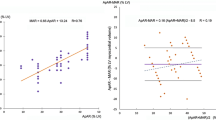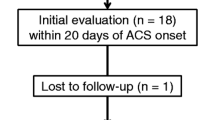Abstract
We compare thallium-201 rest redistribution and fluorine-18 fluorodeoxyglucose ([18F]FDG) for the assessment of myocardial viability within technetium-99m methoxyisobutylisonitrile (MIBI) perfusion defects in 27 patients with chronic stable coronary artery disease. The following studies were performed: (1) stress99mTc-MIBI, (2) rest99mTc-MIBI, (3)201T1 rest-redistribution single-photon emission tomography, (4) [18F]FDG positron emission tomography. The left ventricle was devided into 11 segments on matched tomographic images. The segment with the highest activity at stress was taken as the reference (activity=100%). Perfusion defects at99mTc-MIBI rest were classified as severe (activity<50%), moderate (activity 50%–60%) or mild (activity 60%–85%). Uptakes of [18F]FDG and rest-redistributed201Tl were recognized as significant if they exceeded 50% of that in the reference segment. Among the 33 segments with severe99mTc-MIBI rest perfusion defects, 21 had significant [18F]FDG and 10 significant rest-redistributed201Tl uptake. As regards the 37 segments with moderate defects, [18F]FDG was present in 29 and201Tl in 31, while of the 134 segments with mild defects, 128 showed [18F]FDG uptake, and 131,201Tl uptake. In conclusion, there is an inverse relationship between the severity of99mTc-MIBI perfusion defects and the uptake of rest-redistributed201Tl and [18F]FDG. Both tracers are adequate markers of viability in mild and moderate defects; in severe defects201Tl might underestimate the presence of viability as assessed by [18F]FDG.
Similar content being viewed by others
References
Rigo P, Bailey IK, Griffith LSC, etal. Stress thallium-201 myocardial scintigraphy for the detection of individual coronary arterial lesions in patients with and without previous myocardial infarction.Am J Cardiol 1981; 48: 209–216.
Hoer G, Sebening H, Sauer E, etal. 201-Tl redistribution analysis in early and delayed myocardial scintigrams of patients with coronary heart disease.Eur J Nucl Med 1979; 4: 343–350.
Iskandrian AS, Heo J, Decoskey D, Askenase A, Segal BL. Use of exercise thallium-201 imaging for risk stratification of elderly patients with coronary artery disease.Am J Cardiol 1988; 61: 269–272.
Beller AG. Myocardial perfusion imaging with thallium-201.J Nucl Med 1994; 35: 674–680.
Brown KA, Atland E, Rowen M. Prognostic value of normal technetium-99m-sestamibi cardiac imaging.J Nucl Med 1994; 35: 554–557.
Kiat H, Van Train KF, Maddahi, J etal. Development and prospective application of quantitative two day stress-rest Tc99m methoxy isobutyl isonitrile SPECT for the diagnosis of coronary artery disease.Am Heart J 1990; 120: 1255–1266.
Berman DS, Kiat HS, Van Train KF, Germano G, Maddahi J, Friedman JD. Myocardial perfusion imaging with technetium99m-sestamibi: comparative-analysis of available imaging protocols.J Nucl Med 1994; 35: 681–688.
Kiat H, Maddahi J, Roy LT, Van Train K, Friedman J, Berman DS. Comparison of technetium-99m methoxy isobutyl isonitrile and thallium-201 for evaluation of coronary artery disease by planar and tomographic methods.Am Heart J 1989; 117: 1–11.
Iskandrian AS, Heo J, Kong B, Lyons E, Marsch S. Use of technetium-99m isonitrile (RP-30A) in assessing left ventricular perfusion and function at rest and during exercise in coronary artery disease.Am J Cardiol 1989; 64: 270–275.
Khan J, McGhie I, Akers M, etal. Quantitative rotational tomography with T1-201 and Tc-99m 2-methoxy-isobutyl-isonitrile: a direct comparison in normal individuals and patients with coronary artery disease.Circulation 1989; 79: 1282–1293.
Iskandrian AS, Heo J, Stanberry C. When is myocardial viability an important clinical issue?J Nucl Med 1994; 35 (Suppl): 4S-7S.
Rozanski A, Berman DS, Gray R, etal. Use of thallium-201 redistribution scintigraphy in the preoperative differentiation of reversible and nonreversible myocardial asynergy.Circulation 1981; 64: 936–944.
Ragosta M, Beller GA, Watson DD, Kaul S, Gimple LW. Quantitative planar rest-redistribution 201T1 imaging in detection of myocardial viability and prediction of improvement in left ventricular function after coronary bypass surgery in patients with severely depressed left ventricular function.Circulation 1993; 87: 1630–1641.
Dilsizian V, Freedman NMT, Bacharach SL, Perrone-Filardi P, Bonow R. Regional thallium uptake in irreversible defects.Circulation 1992: 85: 627–634.
Tamaki N, Ohtani H, Yamashita K, etal. Metabolic activity in the areas of new fill-in after thallium-201 reinjection: comparison with positron emission tomography using fluorine-18-deoxyglucose. J Nucl Med 1991; 32: 673–678.
Bonow R, Dilsizian V, Cuocolo A, Bacharach SL. Identification of viable myocardium in patients with chronic coronary artery disease and left ventricular dysfunction. Comparison of thallium scintigraphy with reinjection and PET imaging with 18F-fluorodeoxyglucose.Circulation 1991; 83: 26–37.
Dilsizian V, Perrone Filardi P, James A, etal. Concordance and discordance between stress-redistribution-reinjection and rest redistribution thallium imaging for assessing viable myocardium.Circulation 1993; 88: 941–952.
Ratib O, Phelps ME, Huang SC, Henze E, Selin CE, Schelbert HR. Positron tomography with deoxyglucose for estimating local myocardial glucose metabolism.J Nucl Med 1982; 23: 577–586.
Bergmann SR. Use and limitation of metabolic tracers labeled with positron emitting radionuclides in the identification of viable myocardium.J Nucl Med 1994; 35(Suppl): 15S-22S.
Schelbert HR, Schwaiger M. PET studies of the heart. In: Phelps M, Mazziotta J, Schelbert HR, eds.Positron emission tomography and autoradiography: principles and applications for the brain and the heart. New York: Raven Press; 1986: 581–661.
Di Carli M, Davidson M, Little R, etal. Value of metabolic imaging with positron emission tomography for evaluating prognosis in patients with coronary artery disease and left ventricular dysfunction.Am J Cardiol 1994; 74: 527–533.
Schwaiger M, Hick R. The clinical role of metabolic imaging of the heart by positron emission tomography.J Nucl Med 1991;32:565–578.
Sawada S, Allman K, Muzik O, etal. Positron emission tomography detects evidence of viability in rest technetium-99m sestarnibi defects.J Am Coll Cardiol 1994; 23: 92–98.
Huang H, Lucignani G, Landoni C, etal. Rest distribution of [99m-Tc]MIBI in patients with coronary artery disease assessed by SPET: relation with distribution of [18F]FDG assessed by PET.JNucl Biol Med 1994; 38: 494–498.
Cuocolo A, Maurea S, Pace L, etal. Resting technetium-99m methoxyisobutylisonitrile cardiac imaging in chronic coronary artery disease: comparison with rest-redistribution thallium-201 scintigraphy.Eur J Nucl Med 1993; 20: 1186–1192.
Bonow R, Dilsizian V. Thallium-201 and technetium-99m sestamibi for assessing viable myocardium.J Nucl Med 1992; 33:815–818.
Altehoefer C, vom Dahl J, Buell U, etal. Comparison of thallium-201 single-photon emission tomography after rest injection and fluorodeoxyglucose positron emission tomography for assessment of myocardial viability in patients with chronic artery disease.Eur J Nucl Med 1994; 21: 37–45.
Fleiss JL.Statistical methods for mates and proportions, 2nd edn. New York: Wiley, 1981.
Cicchetti OV, Assessing inter-rater reliability for rating scales: resolving same basic issues.Br J Psychiatry 1976; 129: 452–456.
Piwnica-Worms D, Kronauge J, Chin M. Uptake and retention of hexakis (2-methoxyisobutyl isonitrile) technetium (1) in cultured chick myocardial cells. Mitochondrial and plasma membrane potential dependence.Circulation 1990; 82: 1826–1838.
Lucignani G, Paolini G, Landoni C, etal. Presurgical identification of hibernating myocardium by combined use of technetium-99m hexokinase 2-methoxyisobutylisonitrile single photon emission tomography and fluorine-18 fluoro-2-deoxyglucose positron emission tomography in patients with coronary artery disease.Eur J Nucl Med 1992; 19: 874–881.
Maddahi J, Schelbert H, Brunken R, Di Carli M. Role of thallium-201 and PET imaging in evaluation of myocardial viability and management of patients with coronary artery disease and left ventricular disfunction.J Nucl Med 1994; 35: 707–715.
vom Dahl J, Altehoefer C, Biederman M, etal. Technetium-99m methoxy-isobutyl-isonitrile as a tracer of myocardial viability? A quantitative comparison with coronary artery disease [abstract]. J Am Coll Cardiol 1993: 21 Suppl A: 283A.
Richter WS, Cordes M, Calder D, Eichstaedt H, Felix R. Washout and redistribution between immediate and two hour myocardial images using technetium-99m sestamibi.Eur J Nucl Med 1995; 22: 49–55.
Bisi G, Sciagrà R, Santoro G, Fazzini P. Rest technetium-99m sestamibi tomography in combination with short term administration of nitrates: feasibility and reliability for prediction of postrevascularization outcome of asynergic territories.J Am Coll Cardiol 1994; 24: 1282–1289.
Author information
Authors and Affiliations
Rights and permissions
About this article
Cite this article
Rossetti, C., Landoni, C., Lucignani, G. et al. Assessment of myocardial perfusion and viability with technetium-99m methoxyisobutylisonitrile and thallium-201 rest redistribution in chronic coronary artery disease. Eur J Nucl Med 22, 1306–1312 (1995). https://doi.org/10.1007/BF00801618
Received:
Revised:
Issue Date:
DOI: https://doi.org/10.1007/BF00801618




